Case Study Analysis: GoGo Airlines, Finance and Management Accounting
VerifiedAdded on 2020/04/21
|10
|2066
|444
Case Study
AI Summary
This case study analyzes GoGo Airlines' decision to divisionalise its business to create a low-cost airline, Mega Saver Airways. It explores the advantages and disadvantages of divisionalisation, including the impact on decision-making and costs. The study examines techniques to measure the performance of divisional managers, emphasizing the importance of non-financial measures like the balanced scorecard alongside financial metrics. It delves into the costs associated with working capital, analyzing GoGo Airlines' increasing working capital and methods to control its elements. Furthermore, the case study outlines established management accounting techniques, such as activity-based costing and make-or-buy analysis, for addressing various decision-making problems within the company. The analysis incorporates relevant financial data and highlights the strategic implications of financial decisions for the airline.

Running head: CASE STUDY ANALYSIS
Case Study Analysis
Student’s Name:
University Name:
Author Note
Case Study Analysis
Student’s Name:
University Name:
Author Note
Paraphrase This Document
Need a fresh take? Get an instant paraphrase of this document with our AI Paraphraser
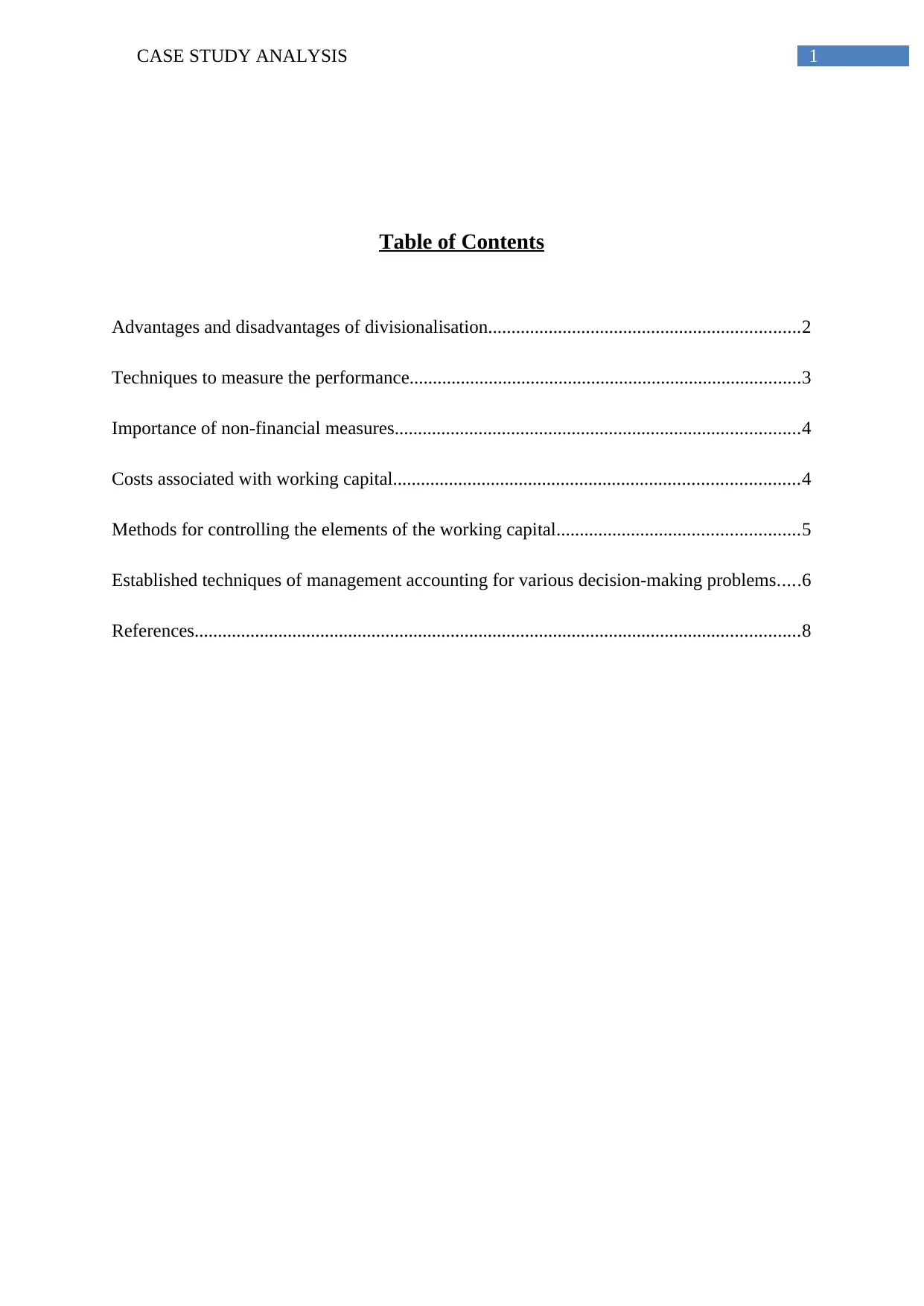
1CASE STUDY ANALYSIS
Table of Contents
Advantages and disadvantages of divisionalisation...................................................................2
Techniques to measure the performance....................................................................................3
Importance of non-financial measures.......................................................................................4
Costs associated with working capital.......................................................................................4
Methods for controlling the elements of the working capital....................................................5
Established techniques of management accounting for various decision-making problems.....6
References..................................................................................................................................8
Table of Contents
Advantages and disadvantages of divisionalisation...................................................................2
Techniques to measure the performance....................................................................................3
Importance of non-financial measures.......................................................................................4
Costs associated with working capital.......................................................................................4
Methods for controlling the elements of the working capital....................................................5
Established techniques of management accounting for various decision-making problems.....6
References..................................................................................................................................8

2CASE STUDY ANALYSIS
Advantages and disadvantages of divisionalisation
The decision of divisionalisation taken by the parent company of GoGo Airlines in
order to develop a low cost airline, Mega Saver Airways for the medium to long haul
category may have both advantageous and disadvantageous implications on business. This is
because GoGo Airlines already has a target group of customers who have till now received
quality service from the airlines company and expect to do the same in the future, therefore
developing a low cost airline by dividing the airline business may certainly have both positive
and negative effects on the already existing business (Cowling 2013).
The decision of dividing the airline business may lead to decentralization of decision
making process which might not be healthy for business given the present situation and
condition. The divisional or the officer in charge might have been given the freedom to set
the tone of the business, determine marketing strategies and other proceedings of the new
extension which if done prudently may be advantageous but if poorly executed might be
disastrous for the entire business. Another major disadvantage of divisionalisation that may
affect GoGo Airlines is that the costs for running the common operations like the accounting
department may rise. Moreover different segments in divisional accounting might face the
issue of conflicts of interest (Carabott 2015).
However the advantages of divisionalisation that can be obtained by business is that
decentralization of the decision making process might improve the quality of operations
undertaken in the new extension of the airline business as the decision making process will be
quick and accurate as because the information does not have to pass along such a long chain
of hierarchy of authority. Moreover GoGo Airlines would be able to compete further with
the new low budget airlines that have popped up in the recent times. The old line of business
would be able to hold the loyal and regular customers while the new line, Mega Savers would
Advantages and disadvantages of divisionalisation
The decision of divisionalisation taken by the parent company of GoGo Airlines in
order to develop a low cost airline, Mega Saver Airways for the medium to long haul
category may have both advantageous and disadvantageous implications on business. This is
because GoGo Airlines already has a target group of customers who have till now received
quality service from the airlines company and expect to do the same in the future, therefore
developing a low cost airline by dividing the airline business may certainly have both positive
and negative effects on the already existing business (Cowling 2013).
The decision of dividing the airline business may lead to decentralization of decision
making process which might not be healthy for business given the present situation and
condition. The divisional or the officer in charge might have been given the freedom to set
the tone of the business, determine marketing strategies and other proceedings of the new
extension which if done prudently may be advantageous but if poorly executed might be
disastrous for the entire business. Another major disadvantage of divisionalisation that may
affect GoGo Airlines is that the costs for running the common operations like the accounting
department may rise. Moreover different segments in divisional accounting might face the
issue of conflicts of interest (Carabott 2015).
However the advantages of divisionalisation that can be obtained by business is that
decentralization of the decision making process might improve the quality of operations
undertaken in the new extension of the airline business as the decision making process will be
quick and accurate as because the information does not have to pass along such a long chain
of hierarchy of authority. Moreover GoGo Airlines would be able to compete further with
the new low budget airlines that have popped up in the recent times. The old line of business
would be able to hold the loyal and regular customers while the new line, Mega Savers would
⊘ This is a preview!⊘
Do you want full access?
Subscribe today to unlock all pages.

Trusted by 1+ million students worldwide

3CASE STUDY ANALYSIS
deal with the entirely new band of customers who are intent to fly at a cheaper rate (Kumar
2015).
Techniques to measure the performance
The techniques that the parent company can employ in order to measure the
performance of the divisional managers and the proposed divisions is that the parent
company may develop a periodic reporting system that shall provide the required data to the
management so that they can evaluate the performance of the concerned entities. The
reporting system may essentially contain those items that are controllable by the divisional
managers like the cost effective techniques employed, the strategies undertaken in order to
compete with the fellow passenger airlines in order to measure their performance. The first
economic component that effectively indicates the performance of a divisional manager or a
proposed division is the divisional controllable profit (Klakegg and Shannon 2013). The
divisional controllable profit constitutes of those revenues and expenses that may be
influenced or can be controlled by a divisional manager. Therefore this particular profit does
not consist of items such as central administrative expenses and fluctuations of the foreign
exchange rate as they cannot be controlled by a divisional manager. Secondly the
contribution of the division to the corporate profit and unallocated corporate sustaining
overhead is another major indicator of the performance of the division (Atrill and McLaney
2015). The third indicator for measuring the performance of the divisional managers and the
division as such is the divisional net income. Though this particular measure has perplexed
outlook and is hard to justify, the main aim of this indicator is to measure the performance of
the division as well as the divisional manager in comparison to the other firms that operate in
the airline industry (Fadeyi et al., 2015).
deal with the entirely new band of customers who are intent to fly at a cheaper rate (Kumar
2015).
Techniques to measure the performance
The techniques that the parent company can employ in order to measure the
performance of the divisional managers and the proposed divisions is that the parent
company may develop a periodic reporting system that shall provide the required data to the
management so that they can evaluate the performance of the concerned entities. The
reporting system may essentially contain those items that are controllable by the divisional
managers like the cost effective techniques employed, the strategies undertaken in order to
compete with the fellow passenger airlines in order to measure their performance. The first
economic component that effectively indicates the performance of a divisional manager or a
proposed division is the divisional controllable profit (Klakegg and Shannon 2013). The
divisional controllable profit constitutes of those revenues and expenses that may be
influenced or can be controlled by a divisional manager. Therefore this particular profit does
not consist of items such as central administrative expenses and fluctuations of the foreign
exchange rate as they cannot be controlled by a divisional manager. Secondly the
contribution of the division to the corporate profit and unallocated corporate sustaining
overhead is another major indicator of the performance of the division (Atrill and McLaney
2015). The third indicator for measuring the performance of the divisional managers and the
division as such is the divisional net income. Though this particular measure has perplexed
outlook and is hard to justify, the main aim of this indicator is to measure the performance of
the division as well as the divisional manager in comparison to the other firms that operate in
the airline industry (Fadeyi et al., 2015).
Paraphrase This Document
Need a fresh take? Get an instant paraphrase of this document with our AI Paraphraser
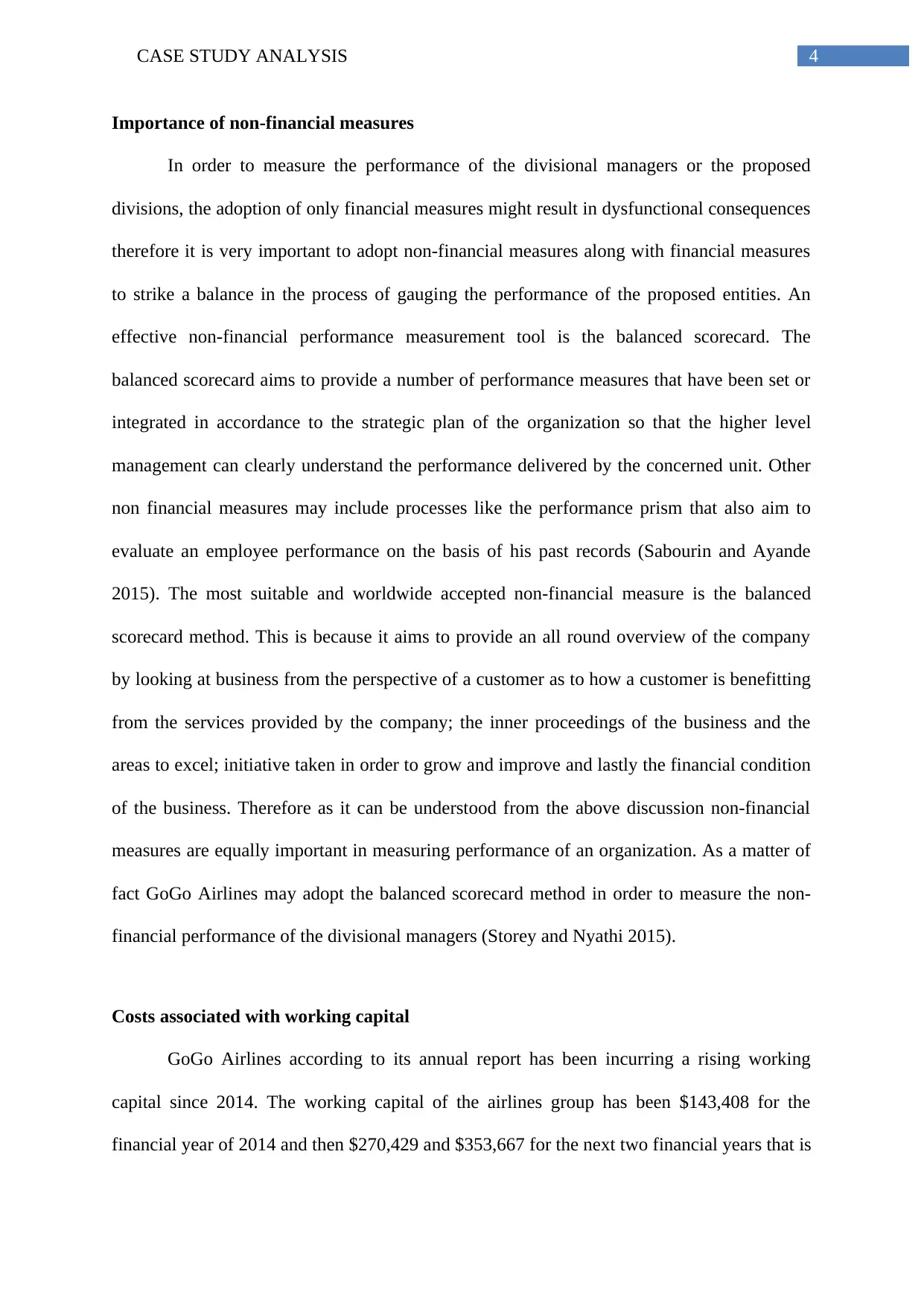
4CASE STUDY ANALYSIS
Importance of non-financial measures
In order to measure the performance of the divisional managers or the proposed
divisions, the adoption of only financial measures might result in dysfunctional consequences
therefore it is very important to adopt non-financial measures along with financial measures
to strike a balance in the process of gauging the performance of the proposed entities. An
effective non-financial performance measurement tool is the balanced scorecard. The
balanced scorecard aims to provide a number of performance measures that have been set or
integrated in accordance to the strategic plan of the organization so that the higher level
management can clearly understand the performance delivered by the concerned unit. Other
non financial measures may include processes like the performance prism that also aim to
evaluate an employee performance on the basis of his past records (Sabourin and Ayande
2015). The most suitable and worldwide accepted non-financial measure is the balanced
scorecard method. This is because it aims to provide an all round overview of the company
by looking at business from the perspective of a customer as to how a customer is benefitting
from the services provided by the company; the inner proceedings of the business and the
areas to excel; initiative taken in order to grow and improve and lastly the financial condition
of the business. Therefore as it can be understood from the above discussion non-financial
measures are equally important in measuring performance of an organization. As a matter of
fact GoGo Airlines may adopt the balanced scorecard method in order to measure the non-
financial performance of the divisional managers (Storey and Nyathi 2015).
Costs associated with working capital
GoGo Airlines according to its annual report has been incurring a rising working
capital since 2014. The working capital of the airlines group has been $143,408 for the
financial year of 2014 and then $270,429 and $353,667 for the next two financial years that is
Importance of non-financial measures
In order to measure the performance of the divisional managers or the proposed
divisions, the adoption of only financial measures might result in dysfunctional consequences
therefore it is very important to adopt non-financial measures along with financial measures
to strike a balance in the process of gauging the performance of the proposed entities. An
effective non-financial performance measurement tool is the balanced scorecard. The
balanced scorecard aims to provide a number of performance measures that have been set or
integrated in accordance to the strategic plan of the organization so that the higher level
management can clearly understand the performance delivered by the concerned unit. Other
non financial measures may include processes like the performance prism that also aim to
evaluate an employee performance on the basis of his past records (Sabourin and Ayande
2015). The most suitable and worldwide accepted non-financial measure is the balanced
scorecard method. This is because it aims to provide an all round overview of the company
by looking at business from the perspective of a customer as to how a customer is benefitting
from the services provided by the company; the inner proceedings of the business and the
areas to excel; initiative taken in order to grow and improve and lastly the financial condition
of the business. Therefore as it can be understood from the above discussion non-financial
measures are equally important in measuring performance of an organization. As a matter of
fact GoGo Airlines may adopt the balanced scorecard method in order to measure the non-
financial performance of the divisional managers (Storey and Nyathi 2015).
Costs associated with working capital
GoGo Airlines according to its annual report has been incurring a rising working
capital since 2014. The working capital of the airlines group has been $143,408 for the
financial year of 2014 and then $270,429 and $353,667 for the next two financial years that is
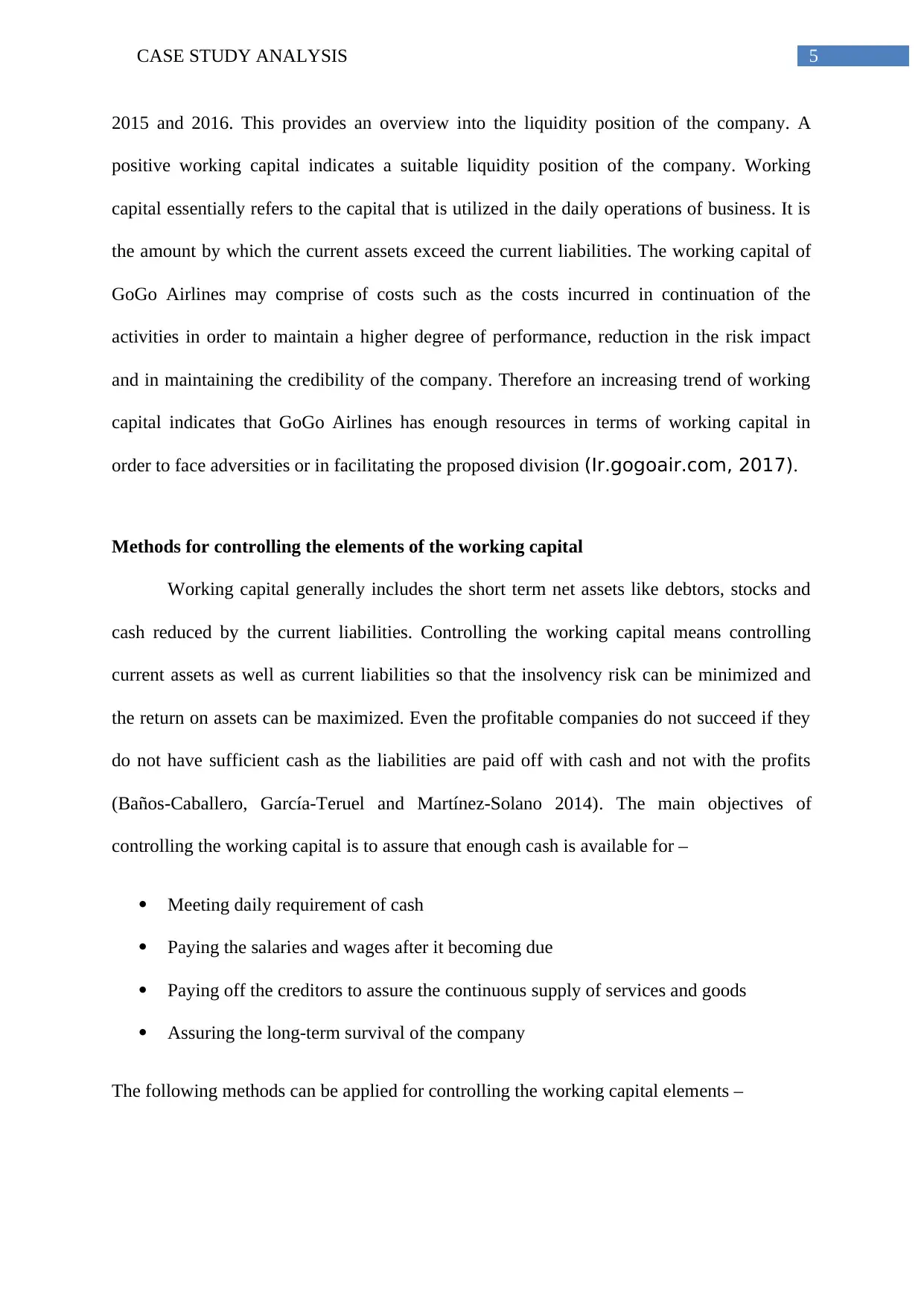
5CASE STUDY ANALYSIS
2015 and 2016. This provides an overview into the liquidity position of the company. A
positive working capital indicates a suitable liquidity position of the company. Working
capital essentially refers to the capital that is utilized in the daily operations of business. It is
the amount by which the current assets exceed the current liabilities. The working capital of
GoGo Airlines may comprise of costs such as the costs incurred in continuation of the
activities in order to maintain a higher degree of performance, reduction in the risk impact
and in maintaining the credibility of the company. Therefore an increasing trend of working
capital indicates that GoGo Airlines has enough resources in terms of working capital in
order to face adversities or in facilitating the proposed division (Ir.gogoair.com, 2017).
Methods for controlling the elements of the working capital
Working capital generally includes the short term net assets like debtors, stocks and
cash reduced by the current liabilities. Controlling the working capital means controlling
current assets as well as current liabilities so that the insolvency risk can be minimized and
the return on assets can be maximized. Even the profitable companies do not succeed if they
do not have sufficient cash as the liabilities are paid off with cash and not with the profits
(Baños-Caballero, García-Teruel and Martínez-Solano 2014). The main objectives of
controlling the working capital is to assure that enough cash is available for –
Meeting daily requirement of cash
Paying the salaries and wages after it becoming due
Paying off the creditors to assure the continuous supply of services and goods
Assuring the long-term survival of the company
The following methods can be applied for controlling the working capital elements –
2015 and 2016. This provides an overview into the liquidity position of the company. A
positive working capital indicates a suitable liquidity position of the company. Working
capital essentially refers to the capital that is utilized in the daily operations of business. It is
the amount by which the current assets exceed the current liabilities. The working capital of
GoGo Airlines may comprise of costs such as the costs incurred in continuation of the
activities in order to maintain a higher degree of performance, reduction in the risk impact
and in maintaining the credibility of the company. Therefore an increasing trend of working
capital indicates that GoGo Airlines has enough resources in terms of working capital in
order to face adversities or in facilitating the proposed division (Ir.gogoair.com, 2017).
Methods for controlling the elements of the working capital
Working capital generally includes the short term net assets like debtors, stocks and
cash reduced by the current liabilities. Controlling the working capital means controlling
current assets as well as current liabilities so that the insolvency risk can be minimized and
the return on assets can be maximized. Even the profitable companies do not succeed if they
do not have sufficient cash as the liabilities are paid off with cash and not with the profits
(Baños-Caballero, García-Teruel and Martínez-Solano 2014). The main objectives of
controlling the working capital is to assure that enough cash is available for –
Meeting daily requirement of cash
Paying the salaries and wages after it becoming due
Paying off the creditors to assure the continuous supply of services and goods
Assuring the long-term survival of the company
The following methods can be applied for controlling the working capital elements –
⊘ This is a preview!⊘
Do you want full access?
Subscribe today to unlock all pages.

Trusted by 1+ million students worldwide
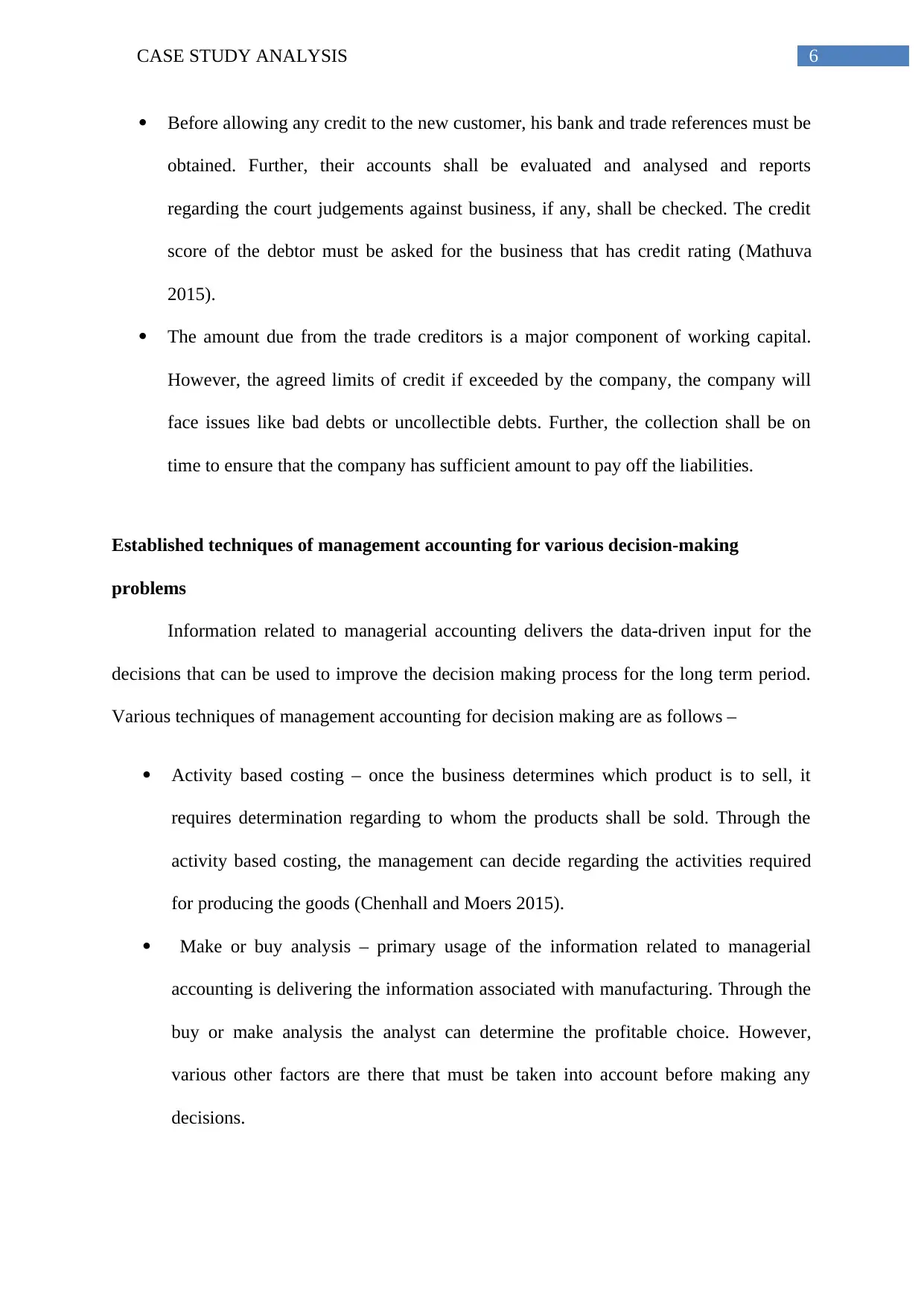
6CASE STUDY ANALYSIS
Before allowing any credit to the new customer, his bank and trade references must be
obtained. Further, their accounts shall be evaluated and analysed and reports
regarding the court judgements against business, if any, shall be checked. The credit
score of the debtor must be asked for the business that has credit rating (Mathuva
2015).
The amount due from the trade creditors is a major component of working capital.
However, the agreed limits of credit if exceeded by the company, the company will
face issues like bad debts or uncollectible debts. Further, the collection shall be on
time to ensure that the company has sufficient amount to pay off the liabilities.
Established techniques of management accounting for various decision-making
problems
Information related to managerial accounting delivers the data-driven input for the
decisions that can be used to improve the decision making process for the long term period.
Various techniques of management accounting for decision making are as follows –
Activity based costing – once the business determines which product is to sell, it
requires determination regarding to whom the products shall be sold. Through the
activity based costing, the management can decide regarding the activities required
for producing the goods (Chenhall and Moers 2015).
Make or buy analysis – primary usage of the information related to managerial
accounting is delivering the information associated with manufacturing. Through the
buy or make analysis the analyst can determine the profitable choice. However,
various other factors are there that must be taken into account before making any
decisions.
Before allowing any credit to the new customer, his bank and trade references must be
obtained. Further, their accounts shall be evaluated and analysed and reports
regarding the court judgements against business, if any, shall be checked. The credit
score of the debtor must be asked for the business that has credit rating (Mathuva
2015).
The amount due from the trade creditors is a major component of working capital.
However, the agreed limits of credit if exceeded by the company, the company will
face issues like bad debts or uncollectible debts. Further, the collection shall be on
time to ensure that the company has sufficient amount to pay off the liabilities.
Established techniques of management accounting for various decision-making
problems
Information related to managerial accounting delivers the data-driven input for the
decisions that can be used to improve the decision making process for the long term period.
Various techniques of management accounting for decision making are as follows –
Activity based costing – once the business determines which product is to sell, it
requires determination regarding to whom the products shall be sold. Through the
activity based costing, the management can decide regarding the activities required
for producing the goods (Chenhall and Moers 2015).
Make or buy analysis – primary usage of the information related to managerial
accounting is delivering the information associated with manufacturing. Through the
buy or make analysis the analyst can determine the profitable choice. However,
various other factors are there that must be taken into account before making any
decisions.
Paraphrase This Document
Need a fresh take? Get an instant paraphrase of this document with our AI Paraphraser
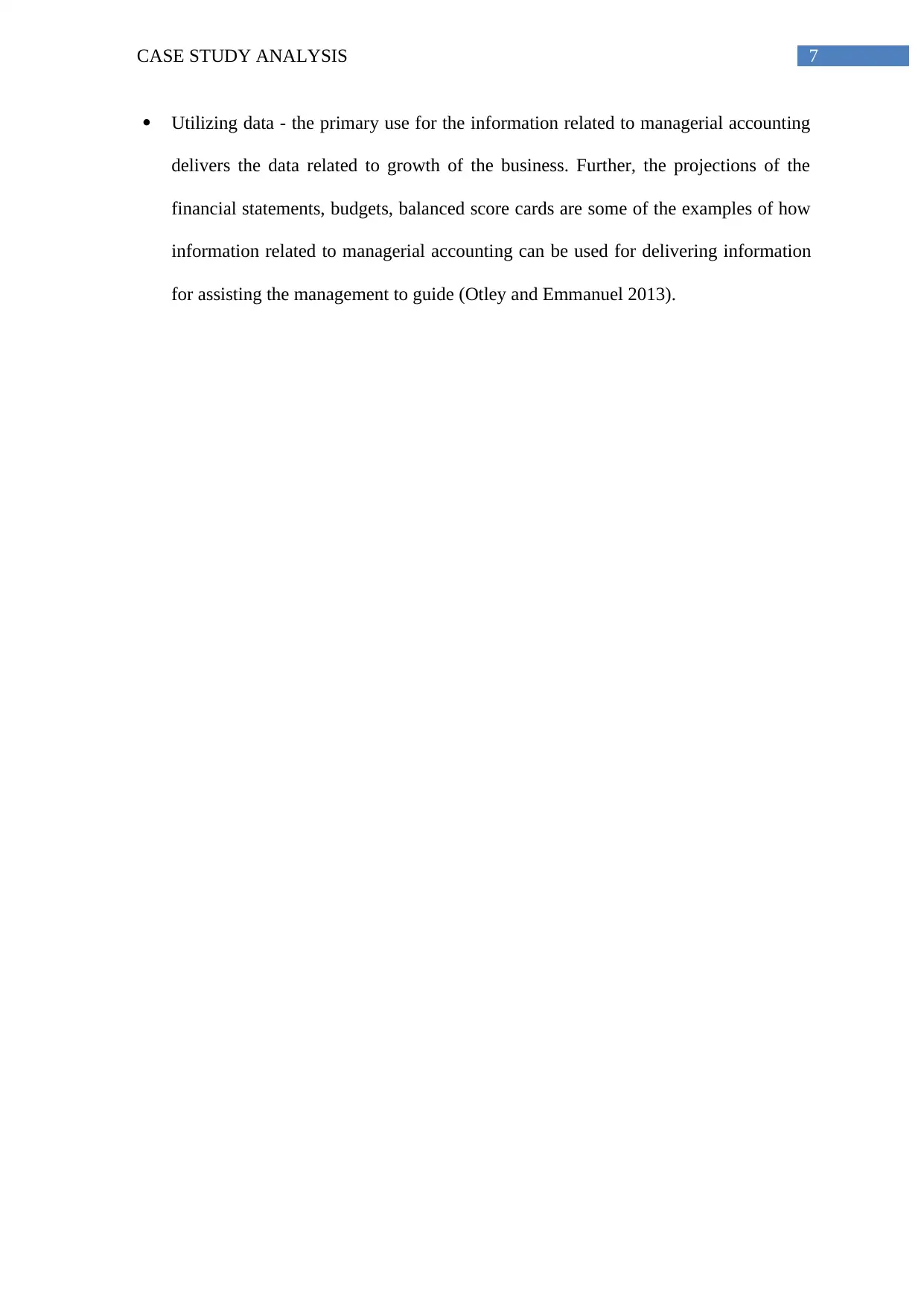
7CASE STUDY ANALYSIS
Utilizing data - the primary use for the information related to managerial accounting
delivers the data related to growth of the business. Further, the projections of the
financial statements, budgets, balanced score cards are some of the examples of how
information related to managerial accounting can be used for delivering information
for assisting the management to guide (Otley and Emmanuel 2013).
Utilizing data - the primary use for the information related to managerial accounting
delivers the data related to growth of the business. Further, the projections of the
financial statements, budgets, balanced score cards are some of the examples of how
information related to managerial accounting can be used for delivering information
for assisting the management to guide (Otley and Emmanuel 2013).
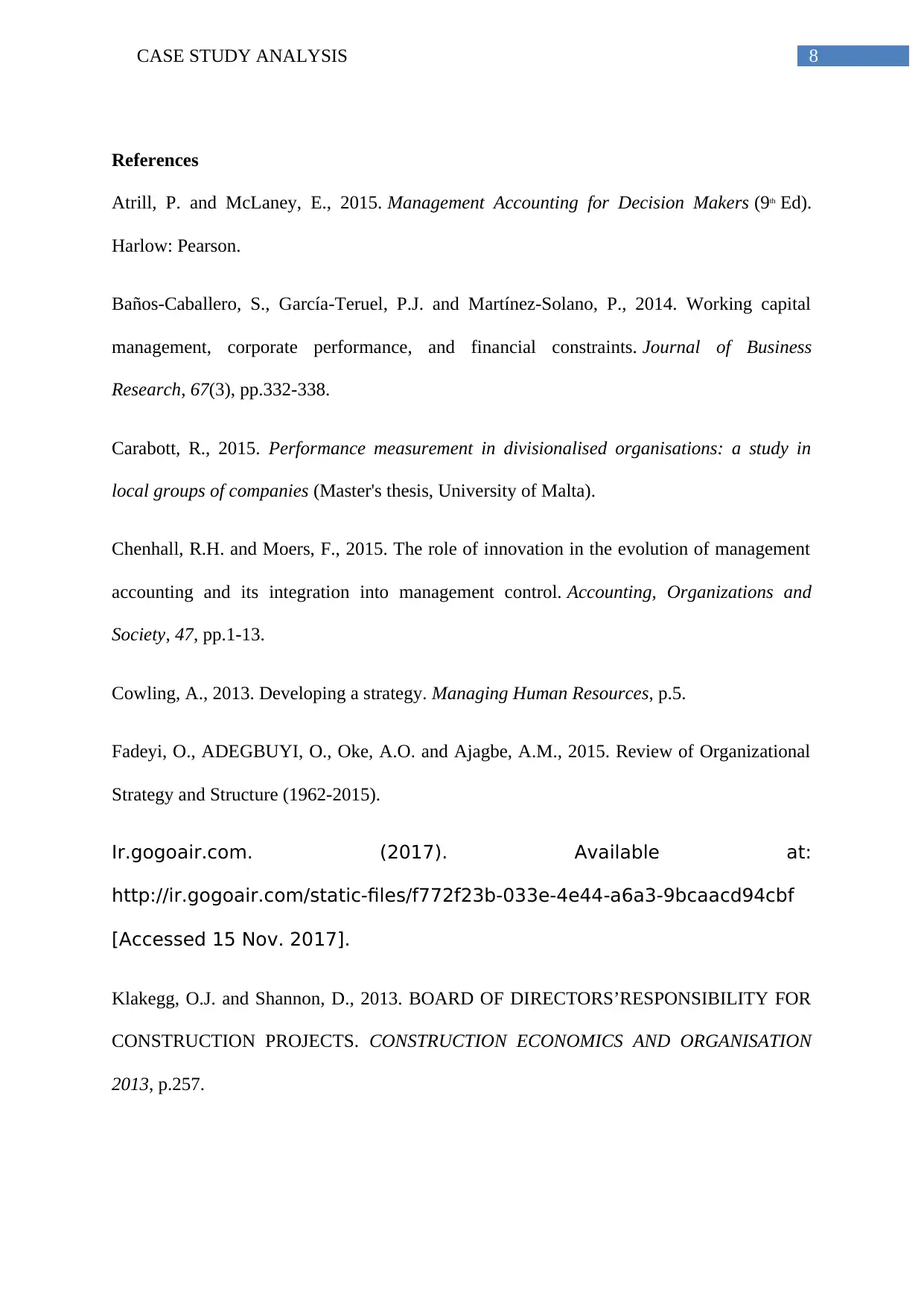
8CASE STUDY ANALYSIS
References
Atrill, P. and McLaney, E., 2015. Management Accounting for Decision Makers (9th Ed).
Harlow: Pearson.
Baños-Caballero, S., García-Teruel, P.J. and Martínez-Solano, P., 2014. Working capital
management, corporate performance, and financial constraints. Journal of Business
Research, 67(3), pp.332-338.
Carabott, R., 2015. Performance measurement in divisionalised organisations: a study in
local groups of companies (Master's thesis, University of Malta).
Chenhall, R.H. and Moers, F., 2015. The role of innovation in the evolution of management
accounting and its integration into management control. Accounting, Organizations and
Society, 47, pp.1-13.
Cowling, A., 2013. Developing a strategy. Managing Human Resources, p.5.
Fadeyi, O., ADEGBUYI, O., Oke, A.O. and Ajagbe, A.M., 2015. Review of Organizational
Strategy and Structure (1962-2015).
Ir.gogoair.com. (2017). Available at:
http://ir.gogoair.com/static-files/f772f23b-033e-4e44-a6a3-9bcaacd94cbf
[Accessed 15 Nov. 2017].
Klakegg, O.J. and Shannon, D., 2013. BOARD OF DIRECTORS’RESPONSIBILITY FOR
CONSTRUCTION PROJECTS. CONSTRUCTION ECONOMICS AND ORGANISATION
2013, p.257.
References
Atrill, P. and McLaney, E., 2015. Management Accounting for Decision Makers (9th Ed).
Harlow: Pearson.
Baños-Caballero, S., García-Teruel, P.J. and Martínez-Solano, P., 2014. Working capital
management, corporate performance, and financial constraints. Journal of Business
Research, 67(3), pp.332-338.
Carabott, R., 2015. Performance measurement in divisionalised organisations: a study in
local groups of companies (Master's thesis, University of Malta).
Chenhall, R.H. and Moers, F., 2015. The role of innovation in the evolution of management
accounting and its integration into management control. Accounting, Organizations and
Society, 47, pp.1-13.
Cowling, A., 2013. Developing a strategy. Managing Human Resources, p.5.
Fadeyi, O., ADEGBUYI, O., Oke, A.O. and Ajagbe, A.M., 2015. Review of Organizational
Strategy and Structure (1962-2015).
Ir.gogoair.com. (2017). Available at:
http://ir.gogoair.com/static-files/f772f23b-033e-4e44-a6a3-9bcaacd94cbf
[Accessed 15 Nov. 2017].
Klakegg, O.J. and Shannon, D., 2013. BOARD OF DIRECTORS’RESPONSIBILITY FOR
CONSTRUCTION PROJECTS. CONSTRUCTION ECONOMICS AND ORGANISATION
2013, p.257.
⊘ This is a preview!⊘
Do you want full access?
Subscribe today to unlock all pages.

Trusted by 1+ million students worldwide
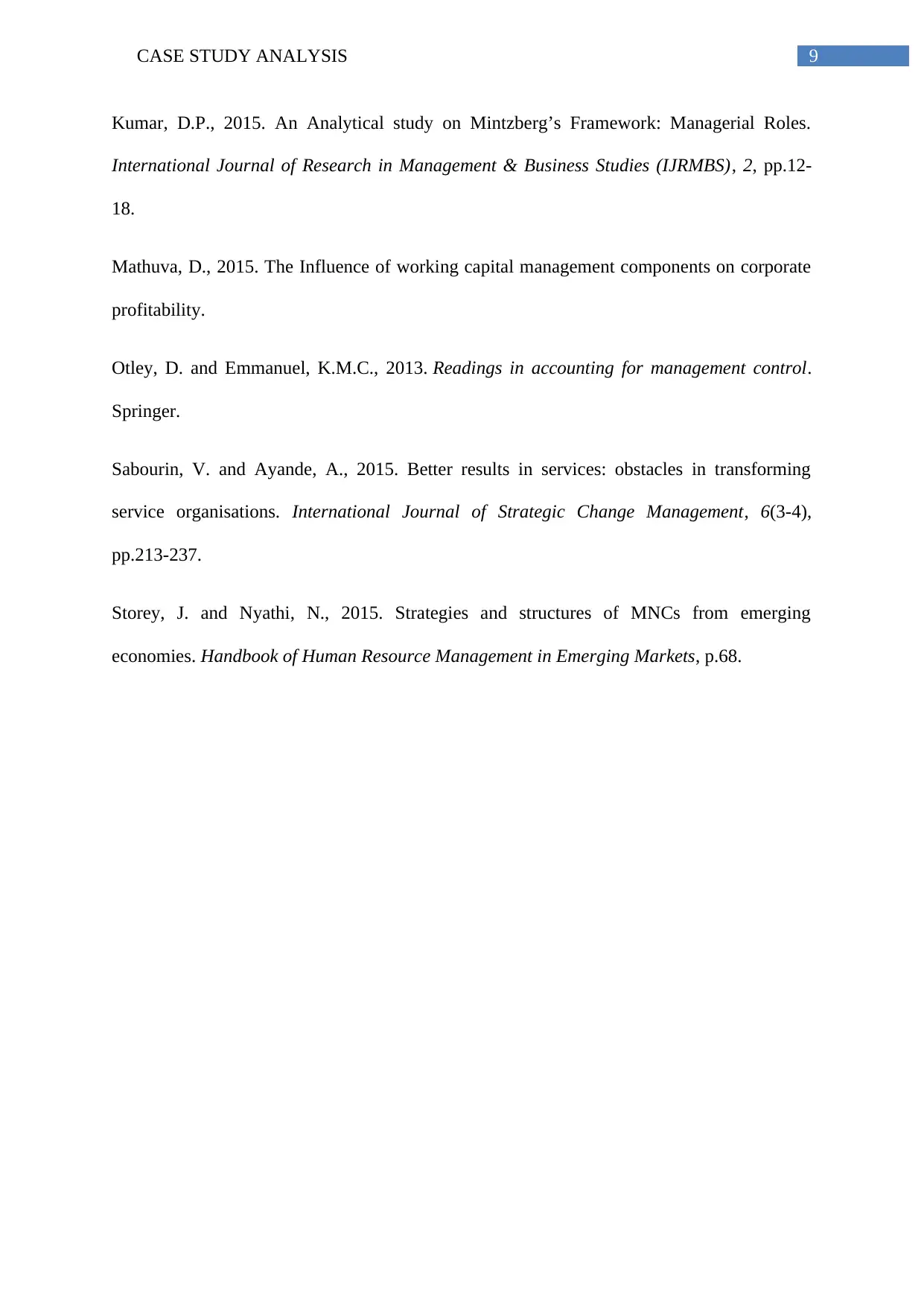
9CASE STUDY ANALYSIS
Kumar, D.P., 2015. An Analytical study on Mintzberg’s Framework: Managerial Roles.
International Journal of Research in Management & Business Studies (IJRMBS), 2, pp.12-
18.
Mathuva, D., 2015. The Influence of working capital management components on corporate
profitability.
Otley, D. and Emmanuel, K.M.C., 2013. Readings in accounting for management control.
Springer.
Sabourin, V. and Ayande, A., 2015. Better results in services: obstacles in transforming
service organisations. International Journal of Strategic Change Management, 6(3-4),
pp.213-237.
Storey, J. and Nyathi, N., 2015. Strategies and structures of MNCs from emerging
economies. Handbook of Human Resource Management in Emerging Markets, p.68.
Kumar, D.P., 2015. An Analytical study on Mintzberg’s Framework: Managerial Roles.
International Journal of Research in Management & Business Studies (IJRMBS), 2, pp.12-
18.
Mathuva, D., 2015. The Influence of working capital management components on corporate
profitability.
Otley, D. and Emmanuel, K.M.C., 2013. Readings in accounting for management control.
Springer.
Sabourin, V. and Ayande, A., 2015. Better results in services: obstacles in transforming
service organisations. International Journal of Strategic Change Management, 6(3-4),
pp.213-237.
Storey, J. and Nyathi, N., 2015. Strategies and structures of MNCs from emerging
economies. Handbook of Human Resource Management in Emerging Markets, p.68.
1 out of 10
Related Documents
Your All-in-One AI-Powered Toolkit for Academic Success.
+13062052269
info@desklib.com
Available 24*7 on WhatsApp / Email
![[object Object]](/_next/static/media/star-bottom.7253800d.svg)
Unlock your academic potential
Copyright © 2020–2025 A2Z Services. All Rights Reserved. Developed and managed by ZUCOL.





